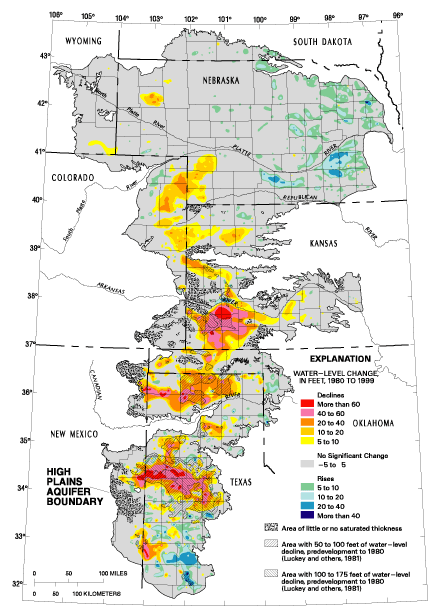At dinner the other night, one of the people at the table commented about the risk we face when the Ogallala Aquifer, beneath the great plains, runs out, which he’d heard would happen in 20 years. Without taking action now to begin regrowing the native grasses needed to hold the plains in place, he’d heard, we faced the risk of another uncontrolled Dust Bowl like the one in that Ken Burns special.
There’s some science to support this, sort of:
Extrapolation of the current depletion rate suggests that 35 percent of the southern High Plains will be unable to support irrigation within the next 30 y.
But that “current depletion rate” caveat is the big “sort of” that exposes a peeve I’ve got about a lot of simplistic thinking about our water future. One can argue (as my dinner companion later did) that Lake Mead and Lake Powell have an x percent chance of going dry by year y, or that the a big part of the Great Plains is going to become another Dust Bowl in 20 years if one assumes that our behavior will continue “at the current depletion rate.”
But there are some unrealistic assumptions embedded here. One is that water users won’t scale back their use to forestall the aquifer’s decline. The other is that farmers don’t have alternatives when faced with less water.
There are a couple of recent things I’ve read (and one I’ve written) that illustrate the point. First, here’s what Mike Haederle wrote for Texas Climate News about the study I quoted from above, what happens when the water runs out:
If irrigation mostly disappears, “a high percentage of it will still be farmed – not necessarily all of it,” Smith says. “It’ll probably be mostly just cotton. Before they had any irrigation, they farmed cotton and some sorghum and some other crops. It’ll go back to that.”
A regional shift away from irrigation has occurred before. In the 1980s, skyrocketing fuel prices hit West Texas farmers who relied on the water- and labor-intensive irrigation systems common at the time, Smith says. “For a lot of them, it was more profitable to go to dryland farming then,” he says.
There’ll likely be economic dislocation, Mike wrote. Dryland farming is less lucrative. But this is a business management challenge, not an existential threat. If you’re worried about doom here, Mike’s piece will allow you to sleep a bit better this evening.
In a similar vein, Brett Walton at Circle of Blue had a fascinating piece last week about efforts by Texas farmers and ag scientists to prepare for a future with less water to work with. It’s a longish piece, well worth a read if you’re concerned about the Ogallala in the long term, but makes three basic points:
- Texas high plains water districts are beginning to restrict withdrawals
- Conversion from irrigation to dryland farming will cause reductions in farm income and jobs, but not an end to farming on the land (and wind power revenue will offset some of the economic dislocation)
- research is underway to develop more viable crops with less water
A similar point came through during my visit to the Hatch Valley last month. Farmers are adapting to the changing environment.
While thinking about the depletion of the Ogallala is an important exercise, a look at what folks are doing in impacted communicaties shows that an assumption of continued depletion at current rates doesn’t quite work for modeling the future.


Also, by then, we’ll have hemp. That won’t need irrigation.
Best,
D
These are all excellent points John – and hopefull as well. We do have options and choices to help us deal with the changing climate and the fact that there is much less water available for yet more people. HOWEVER, I think the person at the dinner was seeing this from a somewhat less optimistic place than you and it is an understandable position to take – especially here in New Mexico where we have failed and continue to fail to “get real” about our water usage. I was very heartened to hear Senator Udall talk in Las Cruces the other day about the need to own up to a new reality and to make some changes. That said, I think we’ve got a terribly long way to go to change powerful attitudes in the state.